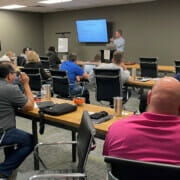7 Steps to Safety Culture
7 Steps to Changing Safety Ideas into Safety Culture
Vertical Alliance Group has hosted free webinars to discuss various aspects of the trucking industry, especially safety. Brian Fielkow, CEO of Jetco Delivery, was one of our guests who joined us to discuss developing a safety culture.
Many companies “talk” about safety, but struggle when it comes to implementing it into their company culture. Fielkow shared practical tips for transforming your organization at every level. He spoke of the importance of everyone adopting safety, from front-line employees to leadership.
He also shared seven behaviors that help you make this transformation happen.
Values vs. Priorities
Many people, when discussing safety, call it a priority for their organization. This sounds good, but lasting organizational change comes when you go from safety priority to safety culture. Safety needs to be a core value for your whole company.
What’s the difference? According to Fielkow, values are the glue that binds a company together. Values are unchangeable, leaving no room to make compromises where they are concerned.
Priorities, on the other hand, can change based on what is happening at the moment for your business. For a real effect, safety needs to be the cornerstone of the organization.
You can’t send mixed messages when it comes to safety for your employees. Your commitment to safety needs to be in the same category as integrity.
Safety is Not a Cost Center
A safety culture is an investment in your company. It is the hallmark of excellent operations. Safety must be sought after, with intention to make operations run smoothly.
Yes, there is cost associated with safety training programs and materials. The ROI on safety makes this cost worth it. Having a healthy and safety conscious team is part of this investment.
Fielkow says, “Safety must be leader driven and employee owned.”
When you start with a strong safety culture, you gain more productivity. This, in turn, brings customer goodwill. No one wants to work with a team riddle with violations and accidents.
The Accident Pyramid
The accident pyramid is a sobering look at how all the tiny decisions to neglect safety lead to tragic outcomes. According to Fielkow, you should never dismiss an accident because it is “minor”.
Minor accidents lead to bigger accidents, and prevention is key. You need to find the root cause that led to the minor accidents before they become a real problem.
Employee behavior is the leading indicator in these situations. You must teach and lead in right behaviors, and this includes performing all required safety inspections. You set the expectations so that employees can manage themselves.
You need to minimize distractions that lead to accidents. Take precautions against those things that get in the way of your safety culture and train your team to focus on safety-sensitive actions.
99% is Not Good Enough
When it comes to safety, you can’t just relax when things are good. You must remain vigilant to adhere to safety best practices.
Fielkow says you have to maintain the mentality of ZERO accidents. It’s an impossible standard, but your mentality must not tolerate preventable incidents.
Safety always starts with leadership. Leaders have to display these safety-focused behaviors themselves and the rest of the employees will copy this.
When issues do happen, address them. Find the rot causes and behaviors so you can change them. Finding solutions to these issues will lead to increased profitability.
Safety Improves Your Bottom Line
Other than fuel, the three largest expenses in transportation are:
- Insurance
- Auto and Workers Comp coverage costs
- Employee turnover
A focus on safety can lead to profits instead of losses in these areas. Excellent safety ratings give you leverage to negotiate better insurance rates. Your company may not be accident free, but an ability to show you have a plan in place matters.
Taking care of your employees is important to your profitability too. When employees know you care, they stay with you. Guide employees toward positive safety behaviors and put best practices in place that will lead to better productivity and highlight safety.
Risk vs. Chance
There is a difference between taking a risk and going with chance when it comes to safety. Risk can be managed and controlled. Chance is all luck.
If a team member exhibits unsafe behaviors, it’s only a matter of time before that luck runs out. Things like texting while driving or skipping pre-inspections lead to poor consequences. Don’t play games with chance.
Risk involves preparing for possible outcomes and making plans based on these possible outcomes. Risk gives you some control whereas chance is out of your hands. Be sure your employees know this difference and avoid chance.
Toxic Employees Lead to Tragic Outcomes
Some employees make changes with teamwork and coaching, which is always great. An employee who will not change, who has no interest in following safety behaviors, who is unwilling to embrace safety culture, is a problem.
If an employee refuses to receive necessary training and remains unwilling to change behaviors, you have to let them go. They put the safety of your team at stake each time they make a poor decision. Everyone in your company needs to be willing to work together for the health and safety of your business.
A company may be compliant, but that does not mean they are safe. Real behavioral changes are needed to ensure better results. From these behavioral changes a true safety culture is formed.
7 Winning Behaviors
For real change to occur in your organization, there are seven behaviors you need to have as safety leadership.
- Don’t accept defeat. Recommit everyday to these important efforts.
- Remember, safety setbacks are inevitable but unacceptable. Accidents are not the “cost of doing business”.
- Be positive and transparent in your efforts. Don’t hide information.
- Own safety, it can’t be delegated.
- Let employees know you care about them. Know the basics and repeat them often.
- Always remain coachable yourself.
- Keep lines of communication open. Let everyone have input into your safety efforts.
And remember, you don’t have to go it alone when it comes to implementing a safety program. Infinit-I Workforce Solutions can be your partner in safety training management.
We have the tools you need to create, implement, and keep your safety culture moving forward. Request a demo today to see our training management system for yourself.










